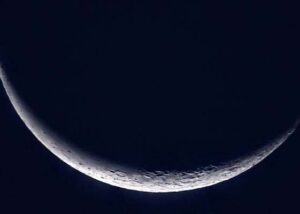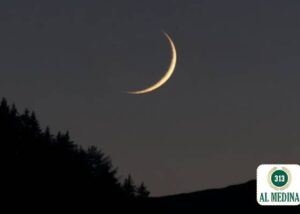How is a lunar month established in the Shafi’i Madhab?
Quran
Hadith
Islamic Text
The lunar month is established by observing the moon.
Praise be to Allah, and His Salutations and Peace be upon our Master Muhammad ﷺ, all believers and his Companions.
The beginning and end of a month is marked by the appearance of the new crescent moon, or the completion of 30 days of a month in the event of a negative naked-eye sighting of a new crescent moon. Contrary to the other three school of jurisprudence, the Shafi’i school considers the beginning and end of the month to be established via the naked-eye sighting of the new crescent moon within a localised region. This phenomenon has a significant affect on various rulings in the Sacred Law, such as menstruation, oaths, fasting, pilgrimage etc. In the Shafi’i school, the establishment to any month is categorised on two levels:
- General public – this refers to the status of the month and its rulings becoming binding on all individuals within a particular localised region;
- Individual – this refers to the new month and its respective rulings becoming binding on the particular individual regardless of the status of the month on the level of the society within a localised region.
On the level of the general public, the beginning and end of any month, apart from Ramadan, is established by naked-eye witnessing of the crescent moon from 2 upright Muslims who bear testimony to this in the presence of a Muslim judge. As for Ramadan, the end of the month is marked similar to the aforementioned; however, the beginning of the month of Ramadan requires only the testimony of 1 upright, Muslim in the same fashion as aforementioned. In order for the testimony of the naked-eye sighting of the new crescent moon to be accepted by the Muslim judge, the sighting must have taken place within a localised region of where the Muslim judge is based. The Muslim judge who rules according to the Shafi’i school can only pass judgement based upon the above. Once the Muslim judge passes judgement, the beginning of the new month and end of the previous month, as well as the rulings that may follow this, will now become binding on the all of the residents within that particular localised region only. Anybody residing outside of this localised region is not obliged to follow the ruling in another region, nor are they permitted do so, unless they decide to follow another valid school of jurisprudence or opinion that allows this. In the event of testimonies of naked-eye sighting of the new crescent moon outside of the localised region or based upon calculations, the Shafi’i Muslim judge cannot pass judgement on these and cannot be made binding on the general public within that particular localised region.
As for the beginning of the new month and end of the previous month on an individual level, this becomes binding on a individual in the following scenarios (the list is not exhaustive) in the Shafi’i School:
- naked eye-sighting of the new crescent moon, whether or not the witness declares this in the presence of a Muslim judge or not and regardless of whether the Muslim judge accepts or rejects the witnesses testimony.
- informed by a Muslim, naked-eye witness who witnessed the new crescent moon within the same localised region they are residents within and the person believes the informer.
- calculations that indicate the beginning of a new month and end of the previous month, although there is a valid difference of opinion amongst the classical scholars of authority in the Shafi’i school regarding this.
- being informed by an expert on calculations that the new month has entered and the one being informed believes this, although this is also an area of valid dispute amongst the classical authorities in the Shafi’i school.
Allah states in verse 189, Surat’ul-Baqarah:
يَسْأَلُونَكَ عَنِ الْأَهِلَّةِ قُلْ هِيَ مَوَاقِيتُ لِلنَّاسِ وَالْحَجِّ
“And they ask you about the new crescent moons. Say, ‘They are timekeeping signs for the people and for Hajj.”
This verse illustrates the use of the new crescent moon in marking the months.
Bukhari (1909) and Muslim (1080 – 4) report on the authority of Abu Hurairah, may Allah be pleased with him, that the Prophet ﷺ said,
صُومُوا لِرُؤْيَتِهِ وَأَفْطِرُوا لِرُؤْيَتِهِ، فَإِنْ غُبِّيَ عَلَيْكُمْ فَأَكْمِلُوا عِدَّةَ شَعْبَانَ ثَلاَثِينَ
“Fast upon seeing it (the new crescent moon), and withhold from fasting upon seeing it (the new crescent moon). If the sky is overcast on you, then complete 30 days of Sha’ban.”
This hadith highlights that the beginning and ending of the month of Ramadan is marked by the sighting of the new crescent moon. In the event it is not sighted, 30 days of the month of Sha’ban is to be completed.
In terms of the evidence for the sighting to be localised to a particular region, this is found in the tradition reported by Muslim (1087 -28) on the authority of Abd-Allah b. Al-‘Abbas, may Allah be pleased with them both, who said,
عَنْ كُرَيْبٍ، أَنَّ أُمَّ الْفَضْلِ بِنْتَ الْحَارِثِ، بَعَثَتْهُ إِلَى مُعَاوِيَةَ بِالشَّامِ، قَالَ: فَقَدِمْتُ الشَّامَ، فَقَضَيْتُ حَاجَتَهَا، وَاسْتُهِلَّ عَلَيَّ رَمَضَانُ وَأَنَا بِالشَّامِ، فَرَأَيْتُ الْهِلَالَ لَيْلَةَ الْجُمُعَةِ، ثُمَّ قَدِمْتُ الْمَدِينَةَ فِي آخِرِ الشَّهْرِ، فَسَأَلَنِي عَبْدُ اللهِ بْنُ عَبَّاسٍ رَضِيَ اللهُ عَنْهُمَا، ثُمَّ ذَكَرَ الْهِلَالَ فَقَالَ: مَتَى رَأَيْتُمُ الْهِلَالَ؟ فَقُلْتُ: رَأَيْنَاهُ لَيْلَةَ الْجُمُعَةِ، فَقَالَ: أَنْتَ رَأَيْتَهُ؟ فَقُلْتُ: نَعَمْ، وَرَآهُ النَّاسُ، وَصَامُوا وَصَامَ مُعَاوِيَةُ، فَقَالَ: ” لَكِنَّا رَأَيْنَاهُ لَيْلَةَ السَّبْتِ، فَلَا نَزَالُ نَصُومُ حَتَّى نُكْمِلَ ثَلَاثِينَ، أَوْ نَرَاهُ، فَقُلْتُ: أَوَ لَا تَكْتَفِي بِرُؤْيَةِ مُعَاوِيَةَ وَصِيَامِهِ؟ فَقَالَ: لَا، هَكَذَا أَمَرَنَا رَسُولُ اللهِ صَلَّى اللهُ عَلَيْهِ وَسَلَّمَ “
“Kurayb narrated that Umm Fadl bt. Al-Harith sent him to Mu’awiyah, who was in the Levant. He (Kurayb) said, ‘I arrived in the Levant and fulfilled her requests. Ramadan had entered whilst I was in the Levant and I saw the new crescent moon on Friday night. Then, I arrived in Madinah at the end of the month and Abd-Allah b. Al-‘Abbas asked me (regarding this) and then he mentioned the new crescent moon and said, ‘When did you see the new crescent moon?’ I responded, ‘We saw it on Friday night.’ He replied, ‘You saw it?’ I said, ‘Yes, and the people saw it and they began fasting and Mu’awiyah began fasting.’ He (Abd-Allah b. Al-‘Abbas) then said, ‘However, we saw it on Saturday night, so we will continue to fast until we complete 30 days or until we see it.’ I then said, ‘Does the sighting of Mu’awiyah not suffice nor his beginning of fasting?’ He said, ‘No, this is how the Messenger of Allah ﷺ commanded us.’”
Imam an-Nawawi (d. 676), may Allah have mercy on him, says in al-Minhaj’ut-Talibin:
يجب صوم رمضان بإكمال شعبان ثلاثين أو برؤية الهلال
“Fasting Ramadan is an obligation by the completion of 30 days of Sha’ban or by sighting the new crescent moon.”
In addition, he states further on:
وإذا رئي ببلد لزم حكمه البلد القريب دون البعيد في الأصح، والبعيد مسافة القصر، وقيل باختلاف المطالع. قلت هذا الأصح والله أعلم
“If it (the new crescent moon) has bee sighted in a place, the consequent rule will also be binding on the places that are in proximity rather than the distance places according to the Asah position. Distant is the distance that permits shortening prayers. Another position states it is based on different Matali’ (regions). I say that the latter is Asah, and Allah knows best.”
These two statements from Imam an-Nawawi, may Allah have mercy on him, highlight the basis to some of the general concepts I have discussed in this answer. For further reference to more specific details, please refer to the page 29 in A. Ash-Shatiri (2012). Fatawa ash-Shatiri. Dar al-Mirath an-Nabawi: Tarim, for reference to further details found in this fatwa.
– Answered by Shaykh Mohammed Jamili, Jeddah, 12th Dhul Hijjah 1442 (22.07.2021)
See also:






